A Power-Forecasting Method for Geographically Distributed PV Power Systems using Their Previous Datasets
Abstract
1. Introduction
2. Operating Principle
2.1. Normalization
2.2. Motion Estimation
2.3. Dataset
2.4. Error Assessment Method
Assesment Method
3. Results
3.1. Optimization of Mesh Size
3.2. Result and Comparison with Other Methods
3.3. Reasons for Error
4. Conclusions
- Correlation between the available amount of data of PV systems and prediction accuracy: All the data we could obtain were used to forecast with the best prediction accuracy in this study. However, we hypothesize that the prediction accuracy depends on the available data. Therefore, it is important to investigate their relationship and to determine the minimum amount of data with which forecasting can be done with a tolerable accuracy.
- The proposed method only forecasts the output power at 30 min ahead, which is the same period as the sampling interval of the data used for the forecast processes. Forecasting other time horizons and evaluating the corresponding error should be performed.
- In the motion estimation, only the two historical points of PV outputs were used while assuming uniform linear motion, as shown in Figure 4. However, there is a possibility that using more history points could improve prediction accuracy, for example, by capturing spiral motion.
Author Contributions
Funding
Acknowledgments
Conflicts of Interest
References
- Renewables 2018 Global Status Report; Ren 21: Paris, France, 2018; ISBN 978-3-9818911-3-3. Available online: https://www.ren21.net/wp-content/uploads/2019/08/Full-Report-2018.pdf (accessed on 21 October 2019).
- Flexible Resources to Help Renewables–Fast Facts 2016. California Independent System Operator. 916.351.4400. California, America. 10 November 2016. Available online: https://www.caiso.com/Documents/FlexibleResourcesHelpRenewables_FastFacts.pdf (accessed on 21 October 2019).
- Ohtake, H.; Shimose, K.I.; Fonseca, J.G.S., Jr.; Takashima, T.; Oozeki, T.; Yamada, Y. Accuracy of the solar irradiance forecasts of the Japan Meteorological Agency mesoscale model for the Kanto region, Japan. Sol. Energy 2013, 98, 138–152. [Google Scholar] [CrossRef]
- Mellit, A.; Pavan, A.M. A 24-h forecast of solar irradiance using artificial neural network: Applications for performance prediction of a grid-connected PV plant at Trieste, Italy. Sol. Energy 2010, 84, 807–821. [Google Scholar] [CrossRef]
- Wang, F.; Mi, Z.; Su, S.; Zhao, H. Short-Term Solar Irradiance Forecasting Model Based on Artificial Neural Network Using Statistical Feature Parameters. Energies 2012, 5, 1355–1370. [Google Scholar] [CrossRef]
- Marquez, R.; Coimbra, C.F.M. Forecasting of global and direct solar irradiance using stochastic learning methods, ground experiments and the NWS database. Sol. Energy. 2011, 85, 746–756. [Google Scholar] [CrossRef]
- Thorey, J.; Mallet, V.; Chaussin, C.; Descamps, L.; Blanc, P. Ensemble forecast of solar radiation using TIGGE weather forecasts and HelioClim database. Sol. Energy 2012, 120, 232–243. [Google Scholar] [CrossRef]
- Available online: https://www.ecmwf.int/en/research/projects/tigge (accessed on 21 October 2019).
- Available online: http://www.soda-pro.com/ (accessed on 21 October 2019).
- Yamazaki, T.; Homma, H.; Wakao, S.; Fujimoto, Y.; Hayashi, Y. Estimation Prediction Interval of Solar Irradiance Based on Weather Classificastion and Support Vector Machines. Electr. Eng. Jpn. 2015, 135, 160–167. [Google Scholar]
- Jamaly, M.; Kleissl, J. Spatiotemporal interpolation and forecast of irradiance data using Kriging. Sol. Energy 2017, 158, 407–423. [Google Scholar] [CrossRef]
- Yang, D.; Dong, T.; Reindl, T.; Jirutitijaroen, P.; Walsh, M.W. Solar irradiance forecasting using spatio-temporal empirical kriging and vector autoregressive models with parameter shrinkage. Sol. Energy. 2014, 103, 550–562. [Google Scholar] [CrossRef]
- Liaoliao, W.; Chenggang, C.; Ning, Y.; Hui, C. Evaluation of solar irradiance on inclined surfaces models in the short-term photovoltaic power forecasting. J. Eng. 2017, 2017, 2226–2230. [Google Scholar] [CrossRef]
- Pelland, S.; Remund, J.; Kleissl, J.; Oozaki, T.; Brabandere, D.K. Photovoltaic and Solar Forecasting: State of the Art. In International Energy Agency Photovoltaic Power Systems Programme; Technical Report IEA-PVPS T14-01; International Energy Agency: Paris, France, 2013. [Google Scholar]
- Rubby, N.; Jayabarathi, R. Prediction the Power Output of a Grid-Connected Solar Panel Using Multi-Input Support Vector Regression. Procedia Comput. Sci. 2017, 115, 723–730. [Google Scholar]
- Fonseca, J.G.; Oozaki, T.; Takashima, T.; Koshimizu, G.; Uchida, Y.; Ogimoto, K. Use of support vector regression and numerically predicted cloudiness to forecast power output of a photovoltaic power plant in Kitakyushu, Japan. Prog. Photovolt. Res. Appl. 2012, 20, 874–882. [Google Scholar] [CrossRef]
- Pierro, M.; Felice, D.M.; Maggioni, E.; Moser, D.; Perotto, A.; Spada, F.; Gornaro, G. Data-driven upscaling methods for regional photovoltaic power estimation and forecast using satellite and numerical weather prediction data. Sol. Energy 2017, 158, 1026–1038. [Google Scholar] [CrossRef]
- Liu, Y.; Li, K.; Bai, K.; Zhang, Z.; Lu, X.; Zhang, K. Short-term power-forecasting method of distributed PV power system for consideration of its effects on load forecasting. J. Eng. 2017, 13, 865–869. [Google Scholar] [CrossRef]
- Liu, W.; Liu, C.; Lin, Y.; Ma, L.; Xiong, F.; Liu, J. Ultra-Short-Term Forecast of Photovoltaic Output Power under Fog and Haze Weather. Energies 2018, 11, 528–550. [Google Scholar]
- Yang, H.T.; Huang, C.M.; Huang, Y.C.; Pai, Y.S. A Weather-Based Hybrid method for 1-Day Ahead Hourly Forecasting of PV Power Output. IEEE Trans. Sustain. Energy 2014, 5, 917–926. [Google Scholar] [CrossRef]
- Killinger, S.; Braam, F.; Muller, B.; Wille-Haussmann, B.; Mckenna, R. Projection of power generation between differently-oriented PV systems. Sol. Energy 2016, 136, 153–165. [Google Scholar] [CrossRef]
- Inman, R.H.; Pedro, H.T.C.; Coimbra, C.F.M. Solar forecasting methods for renewable energy integration. Prog. Energy Combust. Sci. 2013, 39, 535–576. [Google Scholar] [CrossRef]
- Antonanzas, J.; Osorio, N.; Escobar, R.; Urraca, R.; Martinez-de-Pison, F.J.; Antonanzas-Torres, F. Review of photovoltaic power forecasting. Sol. Energy 2016, 136, 78–111. [Google Scholar] [CrossRef]
- Yang, D.; Kleissl, L.; Gueymard, C.A.; Pedro, H.T.C.; Coimbra, C.F.M. History and trends in solar irradiance and PV power forecasting: A preliminary assessment and review using text mining. Sol. Energy 2018, 168, 60–101. [Google Scholar] [CrossRef]
- Kito, S.; Kurimoto, M.; Kato, T.; Suzuki, Y.; Manabe, Y.; Funabashi, T. A study on Satellite Image-Based Forecasting of Ramp Events of Spatial Average Irradiance. In Proceedings of the Joint Technical Meeting on Frontier Technology and Engineering and Metabolism Society and Environmental Systems, FTE-15-005/MES-15-005. Nagoya, Japan, 15–16 January 2015. (In Japanese). [Google Scholar]
- Lorenz, E.; Hammer, A.; Heinmann, D. Short term forecasting of solar radiation based on satellite data. In Proceedings of the EUROSUN2004 (ISES Europe Solar Congress), Freiburg, Germany, 20–23 June 2004. [Google Scholar]
- Chow, C.W.; Belongie, S.; Kleissl, J. Cloud motion and stability estimation for intra-hour solar forecasting. Sol. Energy 2015, 115, 645–655. [Google Scholar] [CrossRef]
- Bernecker, D.; Riess, C.; Angelopoulou, E.; Hornegger, J. Continuous short-term irradiance forecasts using sky images. Sol. Energy 2014, 110, 303–315. [Google Scholar] [CrossRef]
- Miyazaki, Y.; Kondoh, J.; Kameda, Y. Forecasting System Using Actual Multipoint PV Output. In Proceedings of the Grand Renewable Energy, O-Pv-8-5, Yokohama, Japan, 17–22 June 2018. [Google Scholar]
- Lonij, V.P.; Brooks, A.E.; Koch, K.; Cronin, A.D. Analysis of 80 rooftop PV systems in the Tuscon, AZ area. In Proceedings of the 2012 38th IEEE Photovoltaic Specialists Conference, Austin, TX, USA, 3–8 June 2012. [Google Scholar]
- Kondoh, J.; Kameda, Y. Trouble Detection by Comparing Power Generation by Neighbor PV Systems. Tech. J. Smart Grid 2017, 58, 27–32. (In Japanese) [Google Scholar]
- Kameda, Y.; Kishi, H.; Ishikawa, T.; Matsuda, I.; Itoh, S. Multi-frame motion compensation using extrapolated frame by optical flow for lossless Video Coding. In Proceedings of the 2016 IEEE International Symposium on Signal Processing and Information Technology, Limassol, Cyprus, 12–14 December 2016. [Google Scholar]
- Zhang, H.; Cheng, L.; Ding, T.; Cheung, K.W.; Liang, Z.; Wei, Z.; Sun, G. Hybrid method for short-term photovoltaic power forecasting based on deep convolutional neural network. IET Gener. Transm. Distrib. 2018, 12, 4557–4567. [Google Scholar] [CrossRef]
- Seyedmahmoudian, M.; Jamei, E.; Thirunavukkarasu, G.S.; Soon, T.K.; Mortimer, S.; Horan, B.; Stojcevski, A.; Mekhilef, S. Short-Term Forecasting of the Output Power of a Building-Integrated Photovoltaic System Using a Metaheuristic Approach. Energies 2018, 11, 1260–1282. [Google Scholar] [CrossRef]
- Zhou, H.; Zhang, Y.; Yang, L.; Liu, Q.; Yan, K.; Du, Y. Short-Term Photovoltaic Power Forecasting Based on Long Short Term Memory neural Network and Attention Mechanism. IEEE Access 2019, 7, 78063–78074. [Google Scholar] [CrossRef]
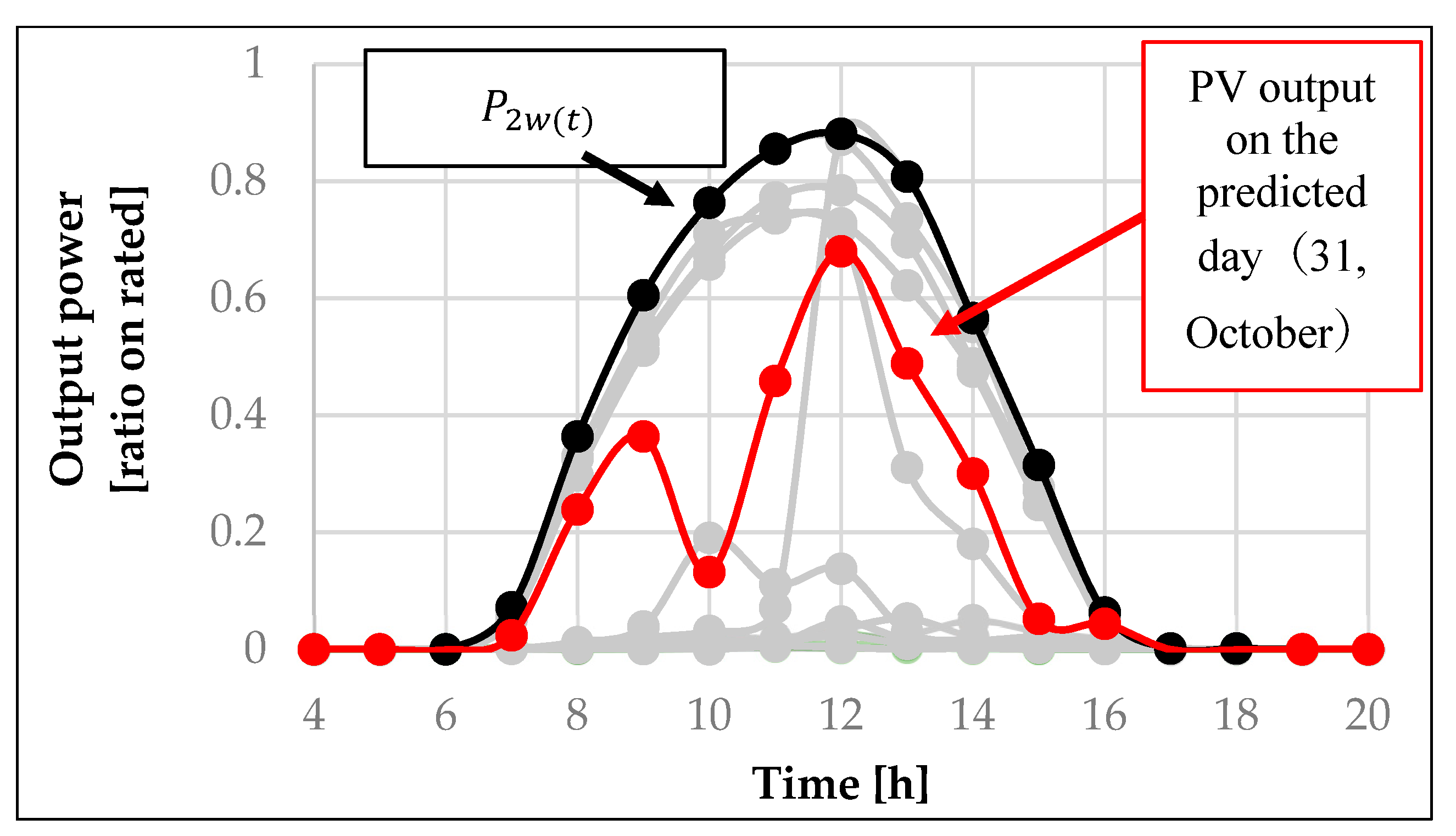
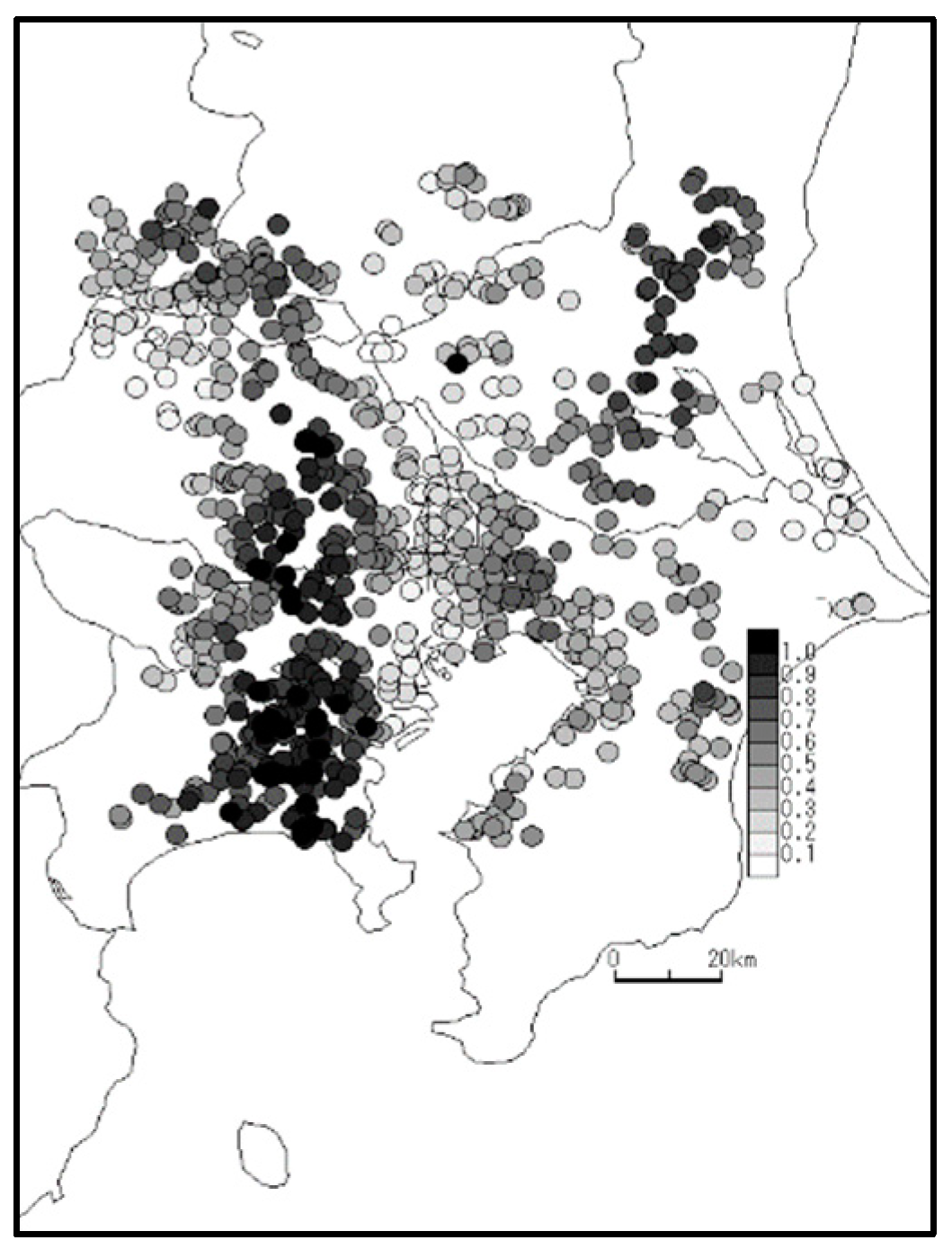
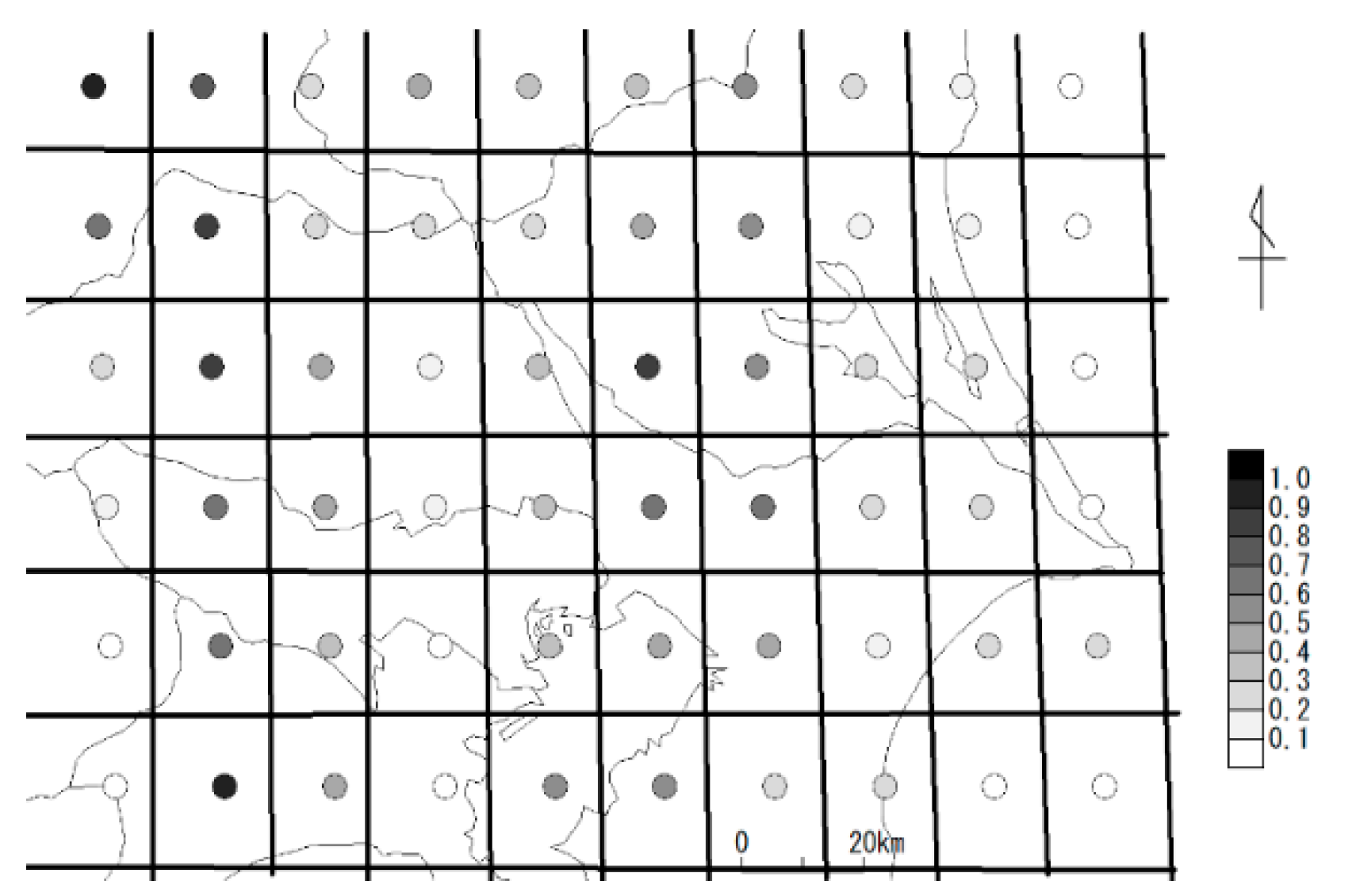
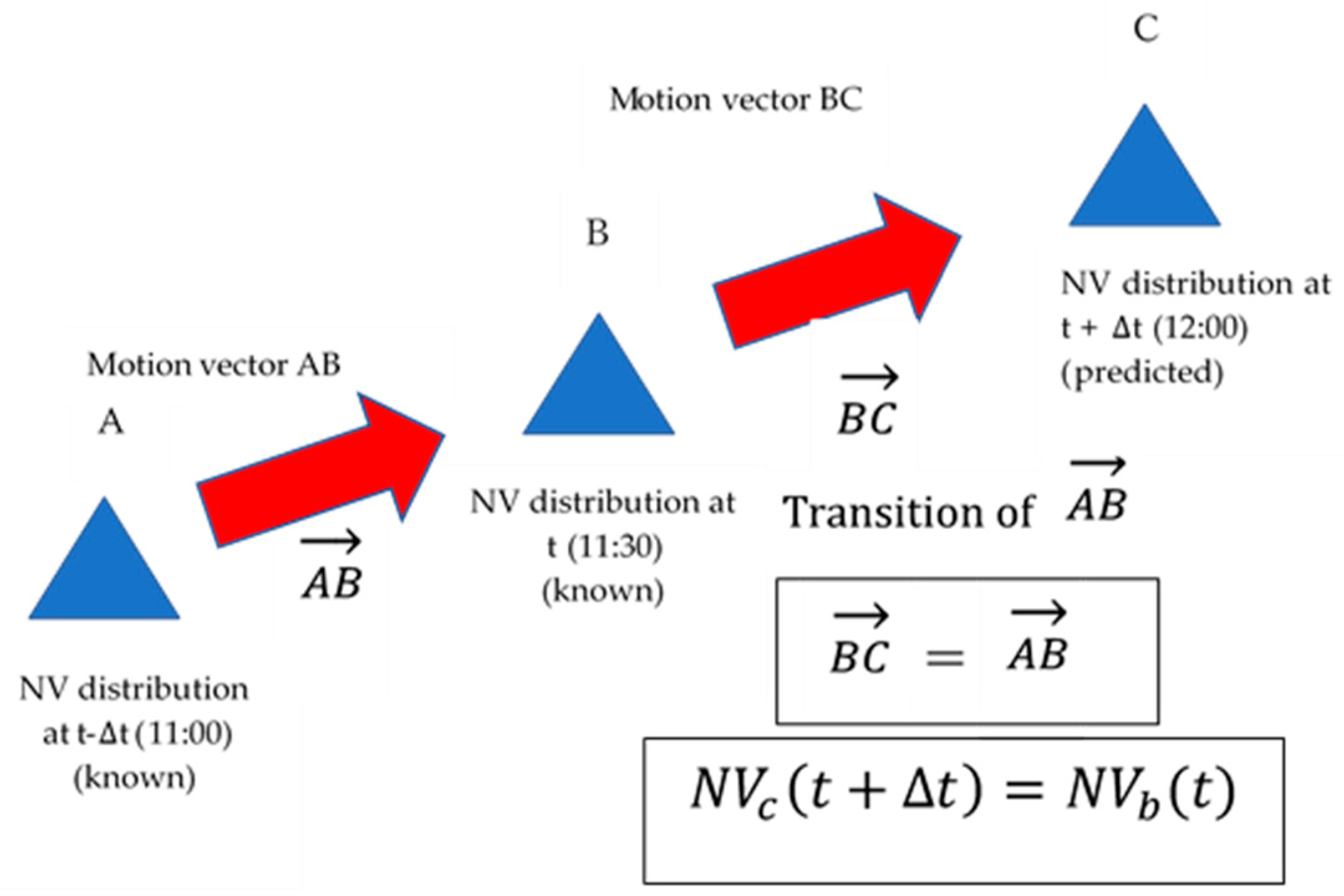
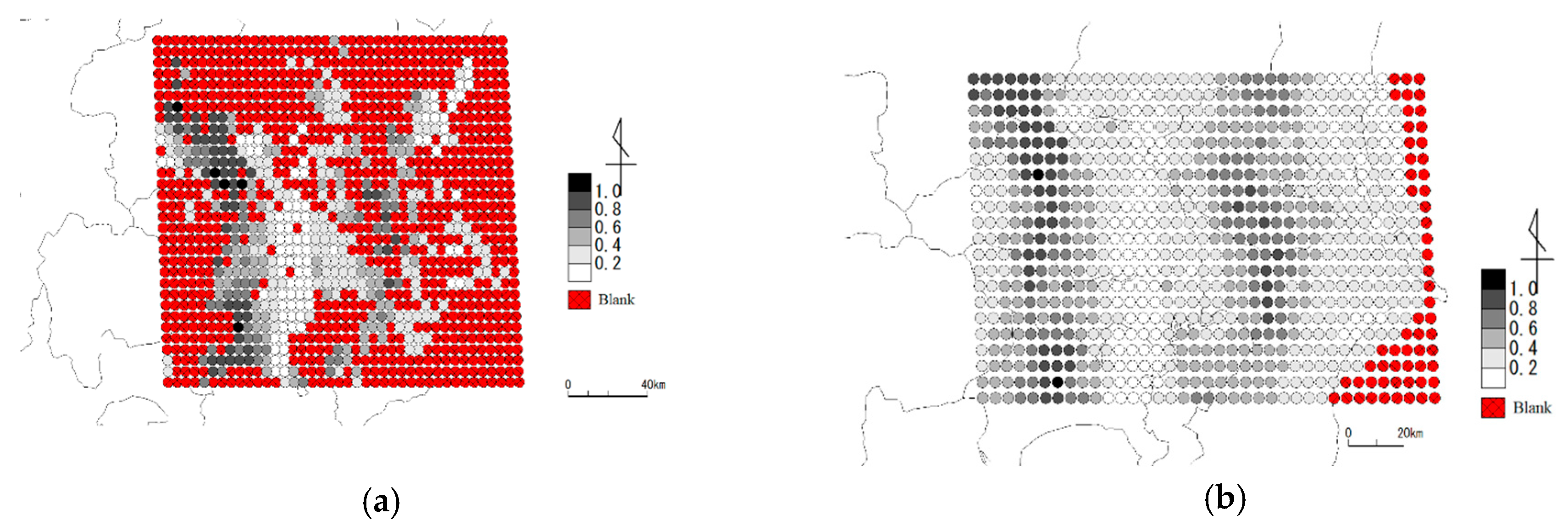
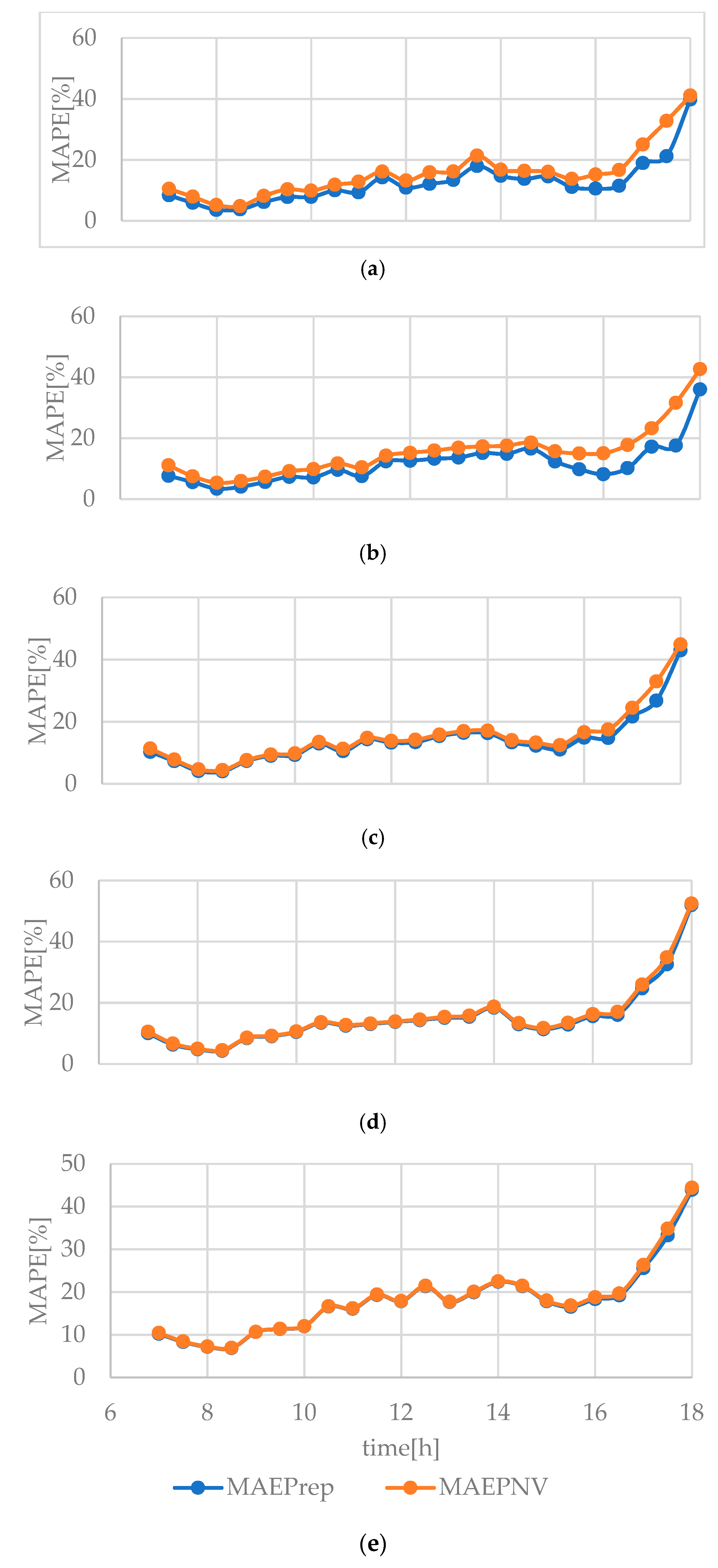
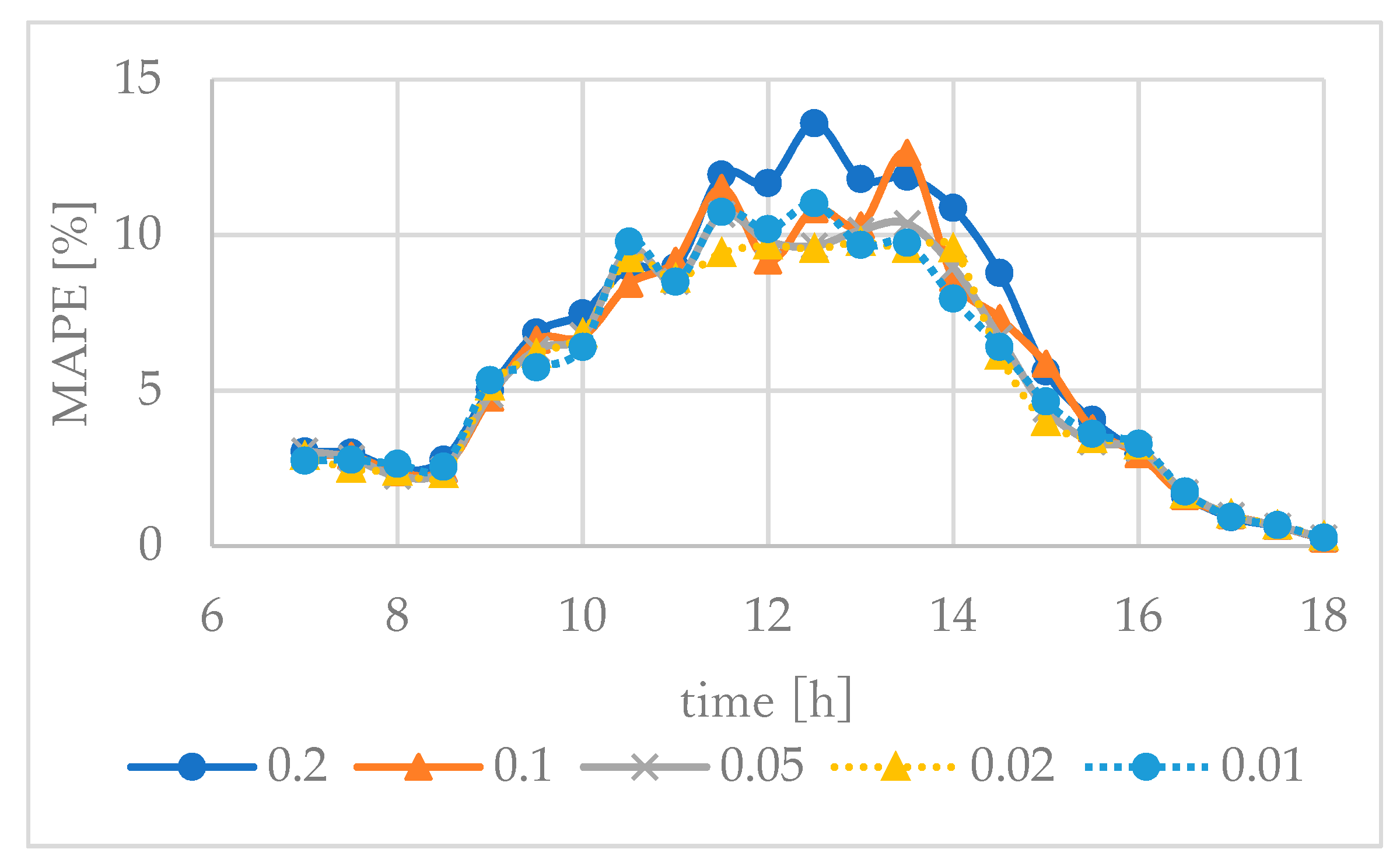

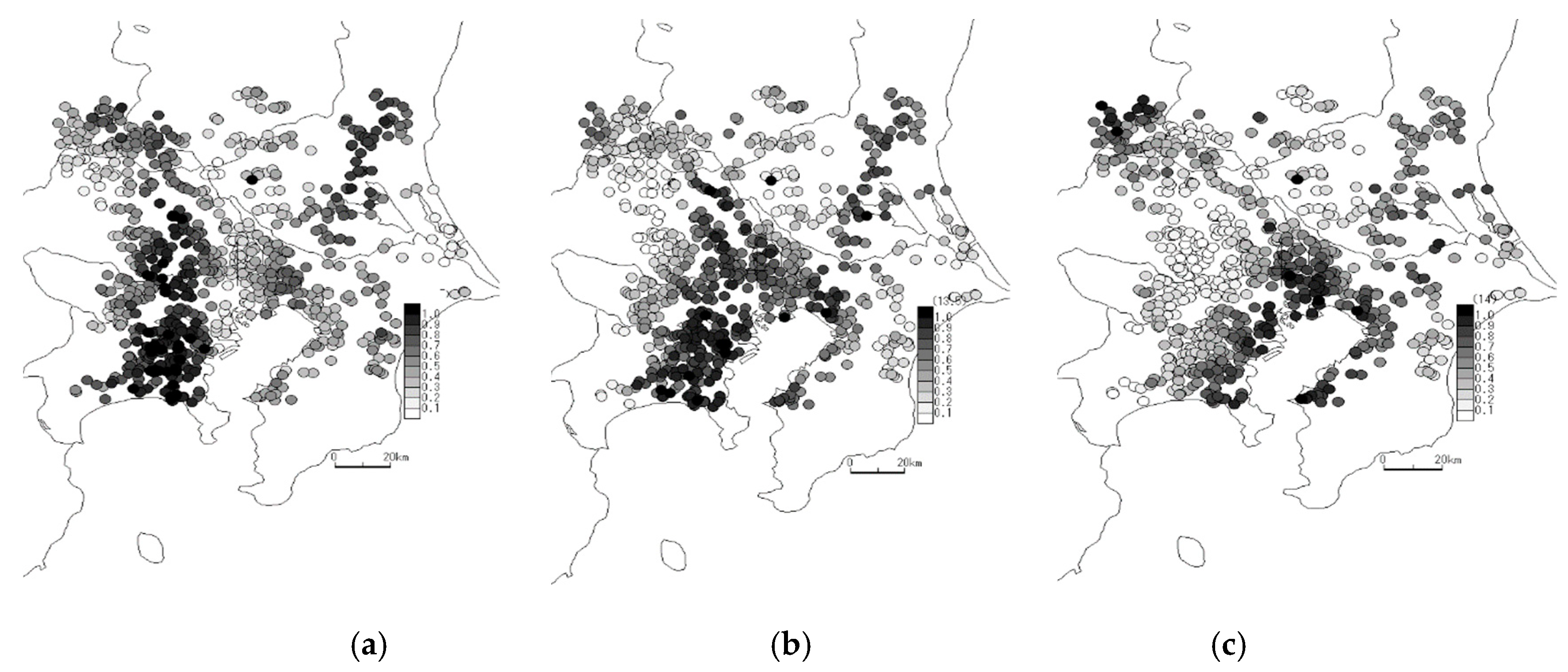
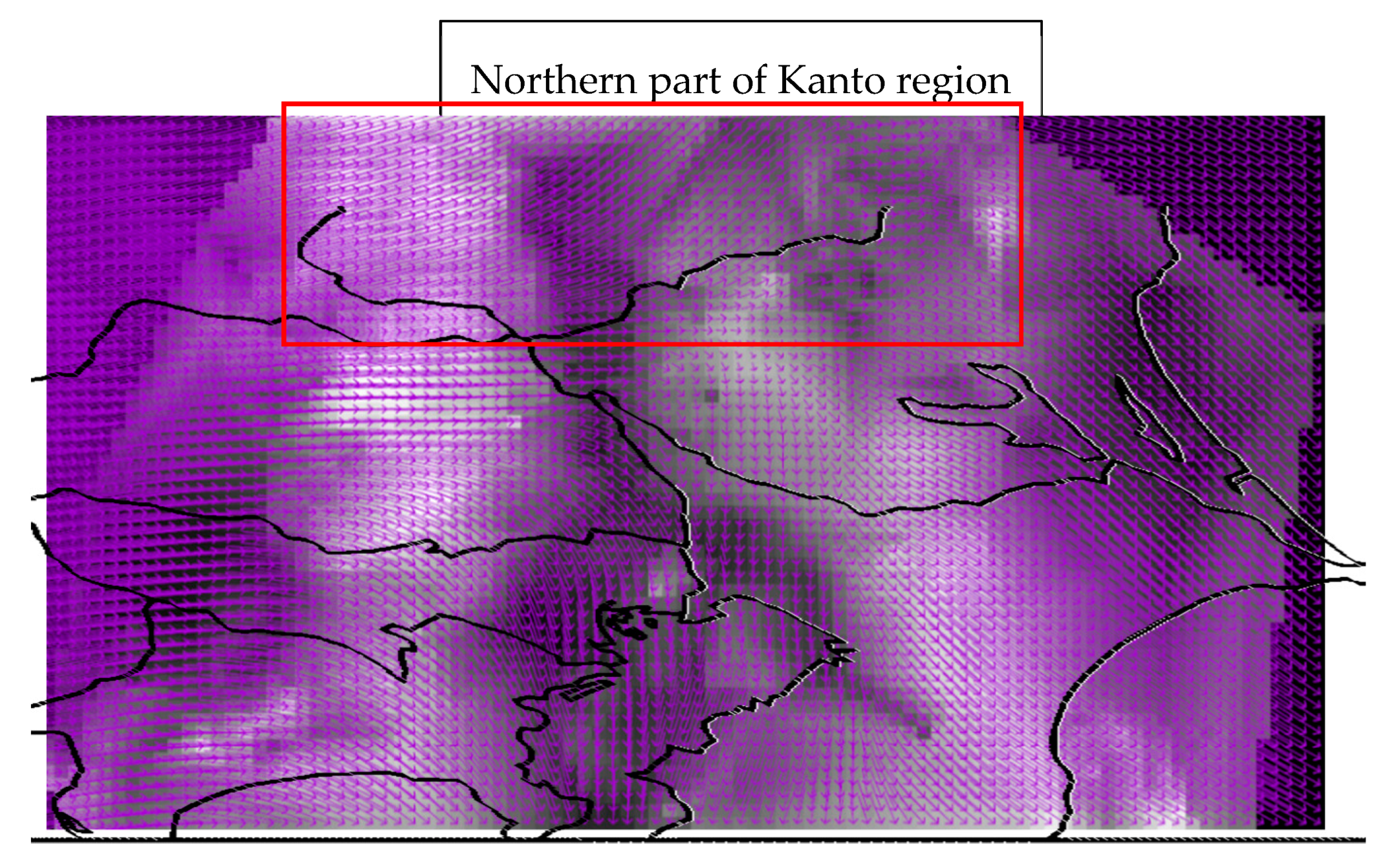
| Date | Weather Condition | MAPE [%] | RMSE [kW] |
|---|---|---|---|
| 19 September 2013 | Sunny | 1.97 | 0.36 |
| 23 September 2013 | Cloudy and rainy | 5.40 | 0.85 |
| 8 October 2013 | Cloudy and sunny | 5.86 | 0.93 |
| 6 June 2014 | Rainy | 2.51 | 0.46 |
| 26 September 2013 | Significant change | 5.39 | 0.87 |
| average | 4.23 | 0.69 |
| Method | Total Rated Power | Number of PV Systems | Forecast Horizon | RMSE |
|---|---|---|---|---|
| Neural network (Zang et al. [33]) | 100 kW | No description | 1 h | 2.05 |
| Metaheuristic approach (Seyedmahmoudian et al. [34]) | 3 kW | 1 system | 1 h | 4.40 |
| Neural network and attention mechanism (Zhou et al. [35]) | 20 kW | 2 systems | 30 min | 1.81 |
| Proposed method | 12 MW | 1200 systems | 30 min | 0.69 |
© 2019 by the authors. Licensee MDPI, Basel, Switzerland. This article is an open access article distributed under the terms and conditions of the Creative Commons Attribution (CC BY) license (http://creativecommons.org/licenses/by/4.0/).
Share and Cite
Miyazaki, Y.; Kameda, Y.; Kondoh, J. A Power-Forecasting Method for Geographically Distributed PV Power Systems using Their Previous Datasets. Energies 2019, 12, 4815. https://doi.org/10.3390/en12244815
Miyazaki Y, Kameda Y, Kondoh J. A Power-Forecasting Method for Geographically Distributed PV Power Systems using Their Previous Datasets. Energies. 2019; 12(24):4815. https://doi.org/10.3390/en12244815
Chicago/Turabian StyleMiyazaki, Yosui, Yusuke Kameda, and Junji Kondoh. 2019. "A Power-Forecasting Method for Geographically Distributed PV Power Systems using Their Previous Datasets" Energies 12, no. 24: 4815. https://doi.org/10.3390/en12244815
APA StyleMiyazaki, Y., Kameda, Y., & Kondoh, J. (2019). A Power-Forecasting Method for Geographically Distributed PV Power Systems using Their Previous Datasets. Energies, 12(24), 4815. https://doi.org/10.3390/en12244815





